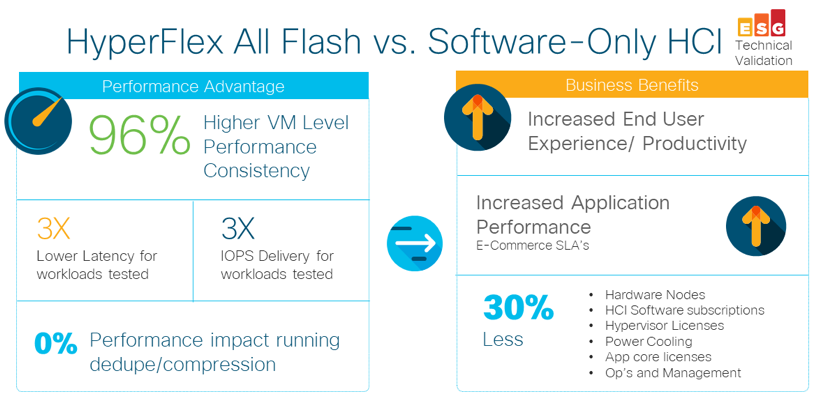What do champions like Michael Phelps, Usain Bolt, and Lionel Messi have in common? They have all elevated their athletic performance to a level where their only competition is themselves. At Cisco, we take inspiration from these world-class athletes to deliver a new hyperconverged solution that introduces a new level of performance to a platform who’s All Flash performance had already left the competition behind.
If you haven’t heard, Cisco is excited to start delivering the new HyperFlex HX220c All NVMe hyperconverged infrastructure (HCI) systems with Intel Optane to our customers, making us the first to market with a fully engineered all NVMe HCI solution.

Engineered Performance, Simplicity, and Scalability
When we launched HyperFlex in 2016, we set out to redefine HCI market. Focused on addressing three core foundational pillars – performance, simplicity, and scalability, to provide our customers with the results that matter to the most– increased end-user productivity, operational efficiency, and reduced total cost of ownership (TCO). We introduced a fully engineered HCI solution centered around a high performance distributed file system, the HyperFlex Data Platform, fully optimized to the UCS compute and networking architecture to deliver unmatched performance per node. This performance advantage enables HyperFlex users to run smaller clusters to maximize TCO savings – something that has been shown in lab reports by the Enterprise Strategy Group (ESG), in the 2017 report, Hyperconverged Infrastructure with Consistent High Performance for Virtual Machines and the 2018 report, Mission-critical Workload Performance Testing of Different Hyperconverged Approaches on the Cisco Unified Computing System Platform (UCS).

HyperFlex All NVMe solutions represent another big step in enhancing the core pillars of the platform, to drive more application performance, enable more workloads on HCI, and deliver more VM density per cluster.

If you’re interested in learning more about the level of engineering work that went into developing a fully engineered all NVMe based HCI appliance, I wrote a blog titled “Engineering the new performance class of hyperconverged infrastructure”, so I won’t get into that here. Instead, let us focus on the burning question…how does it perform compared to All Flash?
Industry-leading HCI performance just got better
So, what do you do when your only competition is yourself? Simple – You do what champions do and raise the bar again!
Working with ESG to leverage the performance numbers a four node HyperFlex All Flash cluster showed in the 2018 report as a base, tests were repeated to see how a four node HyperFlex All NVMe cluster would stack-up running the same SQL, Oracle, and simulated mixed workload environment. The results, as you can see highlighted below, are impressive, to say the least. You can read the full results and ESG’s impressions in the report Mission-critical Hyperconverged Workload Performance Testing on Cisco HyperFlex All NVMe with Intel Optane DC SSD.
First up were the SQL tests, which a four node HyperFlex All NVMe cluster was able to deliver over 772K Aggregate Testing IOPS! That’s 57% more than All Flash, while at the same time reducing read, write, and total latency by 29%, 39%, and 34%.

Next was Oracle testing, which the four node All NVMe cluster showed even more performance gains delivering 71% higher Aggregate Testing IOPS while similarly reducing read, write, and total latency by 36%, 39%, and 37% respectively.

The final test was the mixed workload testing where the performance gains continued with All NVMe delivering 63% higher Aggregate Testing IOPS and reducing read, write, and total latency by 40%, 32%, and 37%.

HCI Performance matters
As IT operating models become distributed through increased utilization of hybrid cloud models and the growth of edge computing, maximizing the operational efficiency of the core datacenter becomes vital. HCI solutions have emerged as a leading solution to modernize datacenter infrastructure and consolidate workloads, but consolidation means HCI solutions now need to support the latency-sensitive applications whose performance requirements previously left reserved for only 3-tier or Converged Infrastructure (CI) solutions. Workloads left siloed in legacy architecture mitigate consolidation benefits, so for HCI solutions to scale to meet today’s needs, the importance of their performance is amplified with it. Yes, you can add nodes to a cluster to scale performance as our competition will point out, but inflated cluster sizes carry heavy costs in the form of hardware, HCI software licensing, and support. As IT environments scale out across hundreds or thousands of locations, density in the core datacenter becomes a priority to preserve operational efficiency.
With the addition of All NVMe options, we’re extending our industry leadership in the HCI market with a new class of hyperconverged performance, engineered to provide datacenter modernization with unmatched VM density and the ability to power even the most performance sensitive workloads. As mentioned earlier, HyperFlex HX220c M5 All NVMe nodes are now orderable, so I encourage you to discuss with your Cisco Datacenter Specialist how they can help you in the next stage of your digital transformation journey.
To learn more about Cisco HyperFlex and HyperFlex All NVMe
Read more about HyperFlex leadership and solutions
- Hyperconverged Infrastructure – Complete Simplicity Requires Complete Solutions
- Taking the Full Power of Hyperconverged Infrastructure to the Edge with HyperFlex Anywhere
- See how HyperFlex performs against the HCI competition
- Deploy Enterprise Apps Solutions on HyperFlex
- Cisco Jumps to Leader in November 2018 Gartner Magic Quadrant for Hyperconverged Infrastructure
New Innovations that redefine
- HyperFlex 4.0 Innovations – Taking the Full Power of Hyperconverged Infrastructure to the Edge with HyperFlex Anywhere
- HyperFlex 3.5 Takes the Stage at Cisco Live 2018 – Make Your Data Center Rock!
- HyperFlex All NVMe Solution – Engineering the new performance class of hyperconverged infrastructure
Intel Blogs
- Put your Applications into Hyperdrive with the Next Generation HyperFlex All NVMe* HCI with Intel® Optane™ DC SSD
- Cisco HyperFlex*, Intel® Xeon® Scalable processors and Intel® Optane™ SSDs: Co-innovating a new class of performance in Hyperconverged Infrastructure
Great news Cale. Keep it coming!